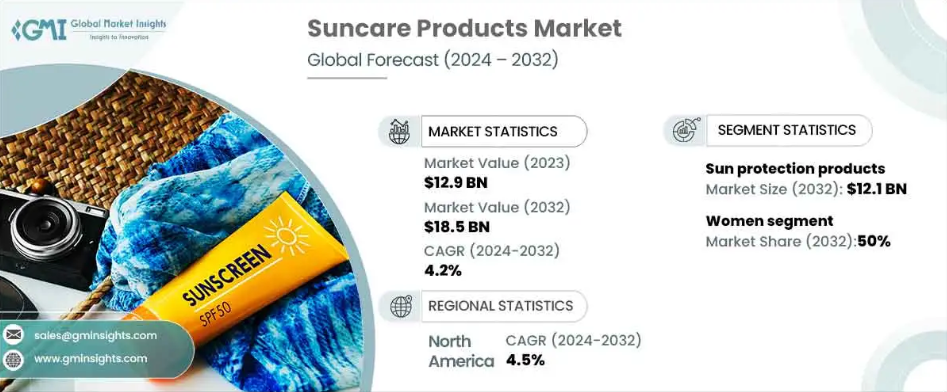Selbyville, Delaware, Sept. 30, 2024 (GLOBE NEWSWIRE) --
Suncare Products Market size was at approximately USD 12.9 billion in 2023. Projections indicate a steady development, with an estimated CAGR of around 4.2% from 2024 to 2032, driven by continuous innovation in suncare formulations.
Request for a sample of this research report @ https://www.gminsights.com/request-sample/detail/10993

Heightened awareness of the risks associated with UV exposure, such as skin cancer and premature aging, leads consumers to prioritize sun protection.
Public health campaigns and educational initiatives have significantly amplified this awareness, resulting in a broader adoption of suncare products. Concurrently, there's a noticeable shift towards products featuring natural and organic ingredients, reflecting a wider trend of health-conscious and eco-friendly consumer choices.
Technological advancements in product formulations have significantly enhanced the appeal and effectiveness of suncare products market. Innovations such as water-resistant, non-greasy, and broad-spectrum formulas meet consumer demands for both protection and comfort. Furthermore, a rising middle class in emerging markets, particularly in Asia Pacific and Latin America, is increasing its spending on personal care products, including suncare. With a surge in global travel and outdoor activities, the demand for suncare solutions has intensified as consumers seek to shield their skin from sun exposure.
The overall suncare products market is classified based on type, price range, form, consumer group, distribution channel, and region.
In 2023, the sun protection products segment generated approximately USD 8.2 billion, with projections to reach USD 12.1 billion by 2032. As consumers become more proactive in preventing UV-induced skin damage, there's a growing interest in anti-aging solutions. Innovations in formulations, such as advanced broad-spectrum protection, water resistance, and lightweight textures, appeal to those seeking effective yet comfortable sun protection. The rising enthusiasm for outdoor activities and sports, combined with a growing middle class in emerging markets with increased disposable income, further drives the demand for sun protection products.
In 2023, suncare products market from women led the segment with a share of approximately 48%, projected to rise to 50% by 2032. As understanding deepens regarding the long-term repercussions of UV exposure, such as skin aging and cancer, women increasingly adopt suncare products as a preventive strategy. They look for multifunctional products that not only shield from the sun but also provide moisturization, hydration, and skin tone enhancement. With a pronounced emphasis on anti-aging, women prioritize products that guard against UV damage and aid in preserving youthful skin. Sun protection has seamlessly integrated into their anti-aging regimens. Recent innovations, like lightweight and non-greasy formulations, alongside products designed for specific skin types—whether sensitive, oily, or dry—cater to the diverse skincare requirements of women.
North America dominated the suncare products market with a share of around 37% in 2023 and is projected to grow at a CAGR of approximately 4.5% from 2024 to 2032, owing to a pronounced emphasis on maintaining youthful skin and preventing aging. Continuous innovations, such as enhanced broad-spectrum protection and varied textures, propel the North American market. Moreover, beauty trends, bolstered by endorsements from celebrities and influencers, play a pivotal role in amplifying consumer interest in the latest suncare innovations.
Request for Report Customization @ https://www.gminsights.com/roc/10993
Major players in suncare products market include Amorepacific Corporation, Avon Products, Inc., Bayer AG, Beiersdorf AG, Clarins Group, Coty Inc., Edgewell Personal Care, Johnson & Johnson, Kao Corporation, L'Oréal Group, Procter & Gamble Co., Revlon, Inc., Shiseido Co., Ltd., The Estée Lauder Companies Inc., and Unilever among others.
Partial Table of Contents (ToC) of the report:
Chapter 1 Methodology & Scope
1.1 Market scope & definitions
1.2 Research design
1.2.1 Research approach
1.2.2 Data collection methods
1.3 Base estimates & calculations
1.3.1 Base year calculation
1.3.2 Key trends for market estimation
1.4 Forecast model
1.4.1 Primary research and validation
1.4.2 Primary sources
1.4.3 Data mining sources
Chapter 2 Executive Summary
2.1 Industry 3600 synopsis, 2021-2032
Chapter 3 Industry Insights
3.1 Industry ecosystem analysis
3.1.1 Factors affecting the value chain
3.1.2 Profit margin analysis
3.1.3 Disruptions
3.1.4 Future outlook
3.1.5 Manufacturers
3.1.6 Distributors
3.1.7 Retailers
3.2 Key news & initiatives
3.3 Regulatory landscape
3.4 Impact forces
3.4.1 Growth drivers
3.4.1.1 Increasing awareness of skin protection
3.4.1.2 Continuous innovation in suncare formulations
3.4.2 Industry pitfalls & challenges
3.4.2.1 Health concerns over chemical ingredients
3.5 Growth potential analysis
3.6 Porter’s analysis
3.7 PESTEL analysis
Browse more skin care industry reports @ https://www.gminsights.com/industry-reports/skin-care/84
About Global Market Insights
Global Market Insights Inc., headquartered in Delaware, U.S., is a global market research and consulting service provider, offering syndicated and custom research reports along with growth consulting services. Our business intelligence and industry research reports offer clients with penetrative insights and actionable market data specially designed and presented to aid strategic decision making. These exhaustive reports are designed via a proprietary research methodology and are available for key industries such as chemicals, advanced materials, technology, renewable energy, and biotechnology.
